
Overview
Psychographic segmentation is crucial for direct-to-consumer (DTC) brands. By understanding consumer motivations and values, brands can significantly enhance their marketing strategies and boost conversion rates. This approach is not just theoretical; it’s backed by compelling data. For instance:
- A clothing brand experienced a remarkable 35% increase in conversion rates.
- A cleaning product company saw an 80% rise in average order value.
These statistics underscore the effectiveness of tailored marketing strategies rooted in psychographic insights.
To truly grasp the power of psychographic segmentation, consider how it allows brands to connect with consumers on a deeper level. By aligning marketing efforts with the values and motivations of their target audience, brands can create more meaningful interactions. This not only fosters brand loyalty but also drives sales.
In conclusion, DTC brands that leverage psychographic segmentation can expect to see tangible results. The evidence is clear: understanding your audience leads to better marketing outcomes. It’s time to take action and integrate psychographic insights into your marketing strategy for enhanced performance.
Introduction
The landscape of direct-to-consumer (DTC) marketing is undergoing a significant transformation. Brands are increasingly recognizing the importance of psychographic segmentation in understanding their audiences. This powerful approach transcends traditional demographics, diving into the motivations, values, and lifestyles that drive consumer behavior.
By leveraging psychographic insights, companies can craft tailored marketing strategies that resonate deeply with their target market. This not only fosters stronger connections but also enhances customer loyalty. However, a pressing question arises: how can brands effectively implement psychographic segmentation to improve engagement and drive substantial sales growth?
To navigate this challenge, brands must first grasp the nuances of their audience's psyche. Understanding what truly motivates consumers allows for the creation of marketing campaigns that speak directly to their desires and needs. As we explore this topic further, we will uncover actionable insights and strategies that can empower brands to harness the full potential of psychographic segmentation.
Parah Group: Leveraging Psychographic Segmentation for Enhanced Conversion Rates
Parah Group expertly harnesses the psychographic segmentation definition to refine its Conversion Rate Optimization strategies, diving deep into the motivations, interests, and values of target consumers. This profound understanding of psychological factors empowers the agency to craft personalized marketing messages and user experiences that truly resonate with potential customers. As a result, companies can anticipate significant enhancements in conversion rates and average order values.
Consider the case of a direct-to-consumer clothing company that partnered with Parah Group to tackle low conversion rates. By redesigning their homepage to emphasize social proof and optimizing product pricing, they achieved an impressive 35% increase in conversion rates and a 10% boost in revenue per visitor. Similarly, Grab Green, a cleaning product company, experienced an astounding 80% increase in average order value after implementing strategic pricing tests and bundling options.
With DTC sales in the U.S. projected to reach $213 billion in 2024—a staggering 178% growth since 2019—the importance of first-party data collection cannot be overstated. Companies are striving to develop more detailed client profiles, enabling even more customized promotional efforts. As industry experts highlight, effective segmentation not only drives customer loyalty but also enhances overall marketing efficiency, making it a crucial component of successful DTC strategies.
To implement the psychographic segmentation definition effectively, DTC companies must regularly update their buyer personas and analyze customer data to adapt to evolving preferences. Parah Group distinguishes itself from other CRO agencies by prioritizing profitability and sustainable growth, leveraging senior-level expertise to craft strategies that align with client goals.

Psychographic Segmentation Defined: Understanding Consumer Behavior Beyond Demographics
The psychographic segmentation definition refers to a powerful tool that classifies individuals based on their psychological characteristics, including personality traits, values, interests, and lifestyles. Unlike demographic segmentation, which only considers observable traits like age and gender, the psychographic segmentation definition explores the deeper motivations and preferences that drive consumer behavior. This approach enables companies to forge stronger connections with their audiences.
Recent studies reveal that businesses leveraging behavioral insights can see a remarkable 25% increase in the effectiveness of their marketing campaigns and a 20% boost in sales. For instance, Coca-Cola has successfully targeted health-conscious millennials through psychographic segmentation, promoting low-calorie beverages that resonate with their values. This strategic shift towards understanding buyer behavior through the psychographic segmentation definition empowers companies to tailor their messaging and offerings, ultimately enhancing customer engagement and loyalty.
In conclusion, the psychographic segmentation definition enriches marketing strategies and fosters a deeper understanding of consumer needs. By focusing on the psychological aspects of their target audience, companies can create more personalized experiences that drive loyalty and satisfaction.

Benefits of Psychographic Segmentation: Enhancing Targeting and Customer Engagement
The psychographic segmentation definition highlights a wealth of advantages, including improved targeting, heightened customer engagement, and strengthened loyalty. By tailoring marketing strategies according to the psychographic segmentation definition of consumers, companies can craft messages that are not only relevant but also compelling. This focused approach significantly boosts conversion rates and fosters enduring relationships with customers, ultimately driving repeat purchases and enhancing loyalty.
Take Patagonia, for instance. This brand has adeptly leveraged consumer behavior insights to connect with eco-conscious shoppers, reinforcing customer loyalty through communications that emphasize sustainability. Similarly, Spotify utilizes psychological data to curate personalized playlists, resulting in increased user engagement and satisfaction.
As we look ahead to 2025, the impact of audience targeting on customer engagement remains profound. Studies indicate that targeted campaigns can lead to a staggering 760% increase in revenue. Marketers embracing this strategy report that 74% believe targeted personalization significantly enhances overall customer engagement. By grasping the values, attitudes, and motivations of their audience, companies can develop emotionally resonant content that not only attracts but also retains customers, solidifying their loyalty and encouraging repeat business.

Methods for Developing Psychographic Segments: From Data Collection to Analysis
Developing psychographic segmentation definition demands a multifaceted approach, integrating surveys, interviews, and social media analysis, all of which can be significantly enhanced through effective Conversion Rate Optimization (CRO) strategies. Brands can gather qualitative insights through customer feedback and focus groups, while quantitative data is often collected via online surveys. Notably, companies excelling in needs-based segmentation report a remarkable 30% increase in leads' willingness to purchase, underscoring the effectiveness of these methods.
Surveys stand out as particularly powerful tools; they allow companies to evaluate consumer attitudes and motivations through diverse question types. By weaving CRO principles into their survey strategies, companies can better align their paid advertisements and landing pages, driving substantial growth and higher conversion rates. For instance, Marriott Hotels have successfully employed contextual segmentation based on external factors, achieving booking conversion rate increases of up to 5%.
Interviews, whether conducted one-on-one or in focus groups, yield deeper insights into buyer motivations and challenges. Companies prioritizing empathetic customer interviews often uncover valuable qualitative data that surveys alone may overlook. This approach not only enhances understanding of the target audience but also fosters a sense of connection and trust, which is crucial for effective CRO.
As companies analyze the gathered data, recognizing patterns and trends becomes essential. This analysis reveals the fundamental motivations and preferences of the target audience, which is crucial for understanding the psychographic segmentation definition and facilitating the creation of unique personality profiles. By integrating these insights into their promotional strategies and leveraging CRO techniques, brands can craft more personalized and resonant campaigns, ultimately driving engagement and loyalty.

Case Studies: How Brands Like Nike and Airbnb Utilize Psychographic Segmentation
Brands like Nike and Airbnb showcase the undeniable power of the psychographic segmentation definition in honing their marketing strategies. Nike adeptly targets consumers who value fitness and self-improvement, crafting campaigns that resonate profoundly with their aspirations for personal growth and achievement. Take, for instance, the iconic 'Just Do It' campaign; it not only champions athleticism but also inspires individuals to embrace a mindset of determination and resilience, forging a strong emotional connection with the brand.
In a similar vein, Airbnb captivates travelers in search of unique and authentic experiences, highlighting values such as adventure, community, and belonging. By customizing its marketing messages to reflect the varied motivations of its users, Airbnb significantly boosts user engagement and loyalty. Their strategy includes personalized recommendations based on travel preferences, which has played a crucial role in their growth and user satisfaction.
The effectiveness of these strategies is underscored by compelling statistics:
- Nike's emphasis on psychographic insights has resulted in heightened brand loyalty and an expanded market presence.
- Airbnb's segmentation initiatives have led to improved booking conversion rates and enhanced user experiences.
Beyond these prominent brands, case studies from Parah Group illustrate the transformative impact of psychographic segmentation in the direct-to-consumer (DTC) space:
- A $30M apparel brand collaborated with Parah Group to tackle low conversion rates. By redesigning their homepage to showcase social proof and optimizing product pricing, they achieved a remarkable 35% increase in conversion rates and a 10% rise in revenue per visitor.
- Grab Green, a $15M cleaning product brand, adopted strategies such as free shipping thresholds and bundle offers, resulting in an impressive 80% increase in average order value (AOV).
These statistics highlight the effectiveness of the psychographic segmentation definition in driving impactful promotional efforts. The success stories from Parah Group further demonstrate how a profound understanding of customer motivations can lead to enhanced profitability and stronger connections with clients, ultimately propelling business growth.
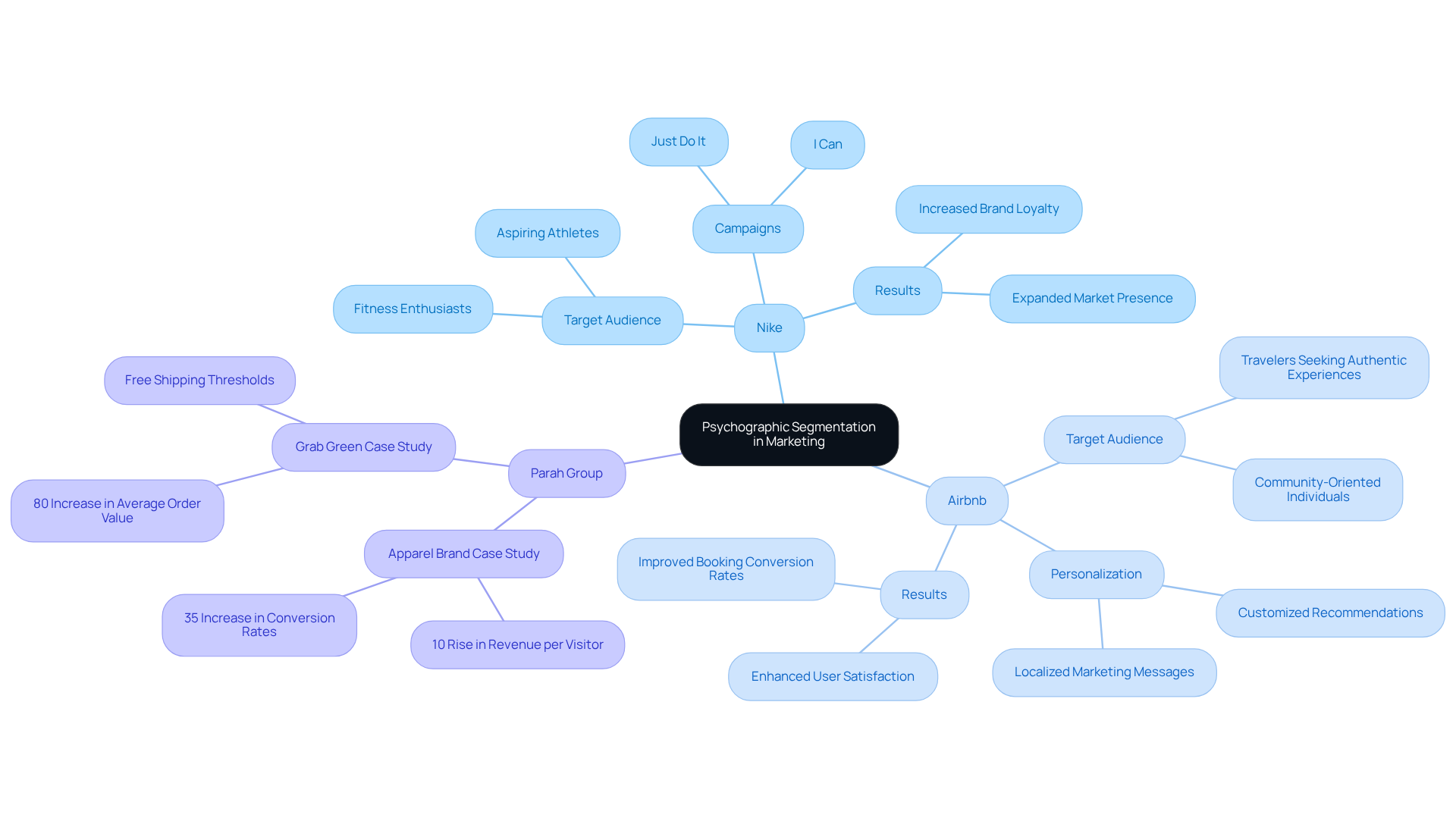
Psychographic Segmentation's Role in Marketing Effectiveness: Driving Sales and Loyalty
The psychographic segmentation definition is crucial for enhancing promotional effectiveness. By allowing companies to tailor their messaging and products to align with audience values and motivations, this approach not only drives sales but also fosters customer loyalty. Consumers are more likely to engage with brands that resonate with their personal beliefs and lifestyles.
Utilizing psychological insights enables companies to craft marketing campaigns that attract new clients while retaining existing ones. For instance, brands that understand their audience's motivations can create targeted promotions that speak directly to their needs. This strategic alignment is not just beneficial; it’s essential in today’s competitive market.
In conclusion, companies must leverage the psychographic segmentation definition to develop impactful marketing strategies. By doing so, they can ensure their messaging resonates deeply with consumers, ultimately leading to increased engagement and loyalty.
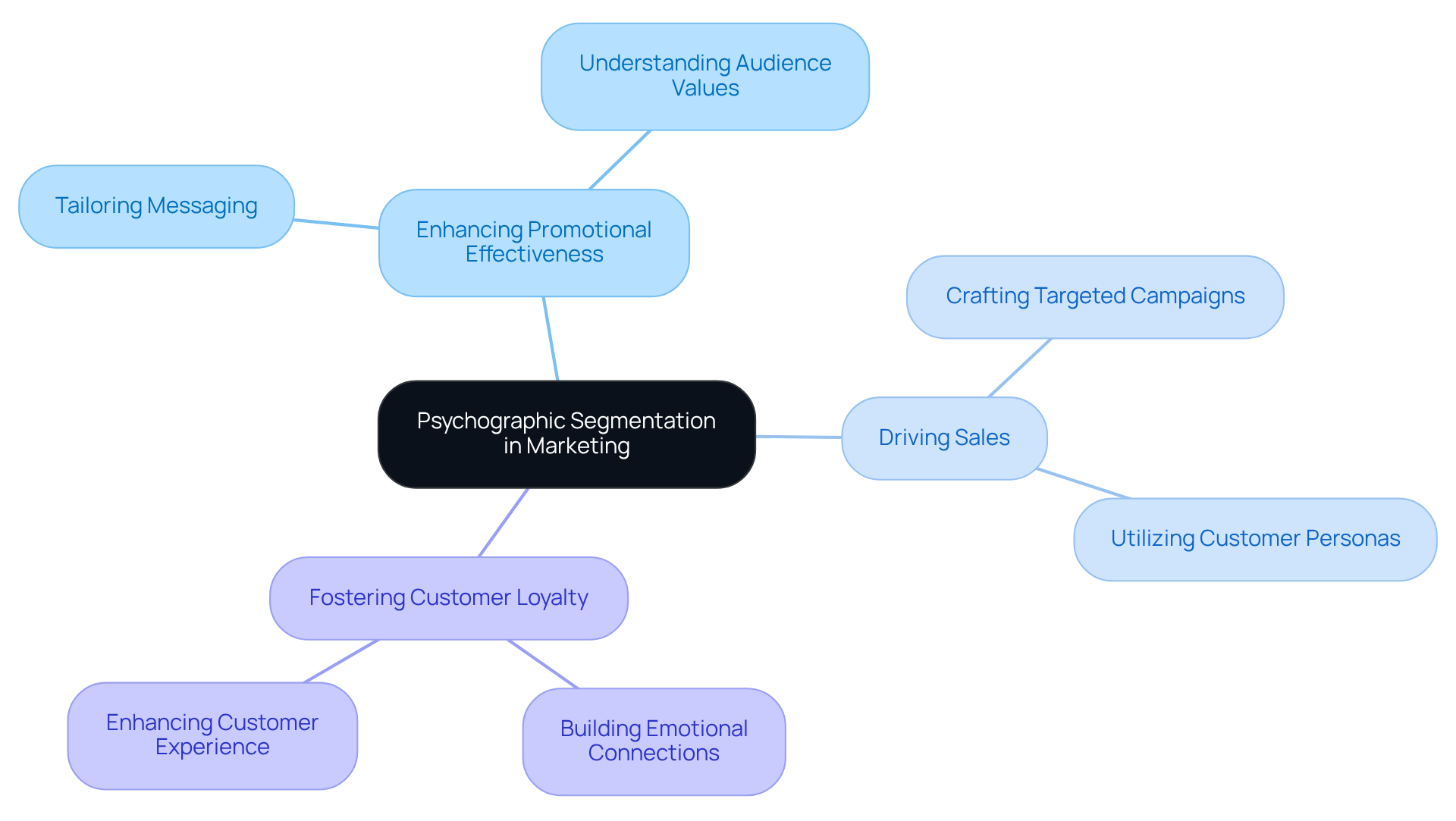
Key Psychographic Variables: Personality, Values, and Lifestyle Insights
The psychographic segmentation definition emphasizes that key psychographic variables—such as personality traits, core values, and lifestyle choices—are crucial for effective audience segmentation. Understanding these variables empowers companies to tailor their marketing strategies with precision.
For instance, a brand targeting environmentally conscious consumers should highlight principles like sustainability and ethical sourcing. This alignment not only resonates with the audience but also fosters a deeper emotional connection, ultimately driving engagement and loyalty.
By leveraging these insights, companies can enhance their marketing effectiveness and build lasting relationships with their customers.
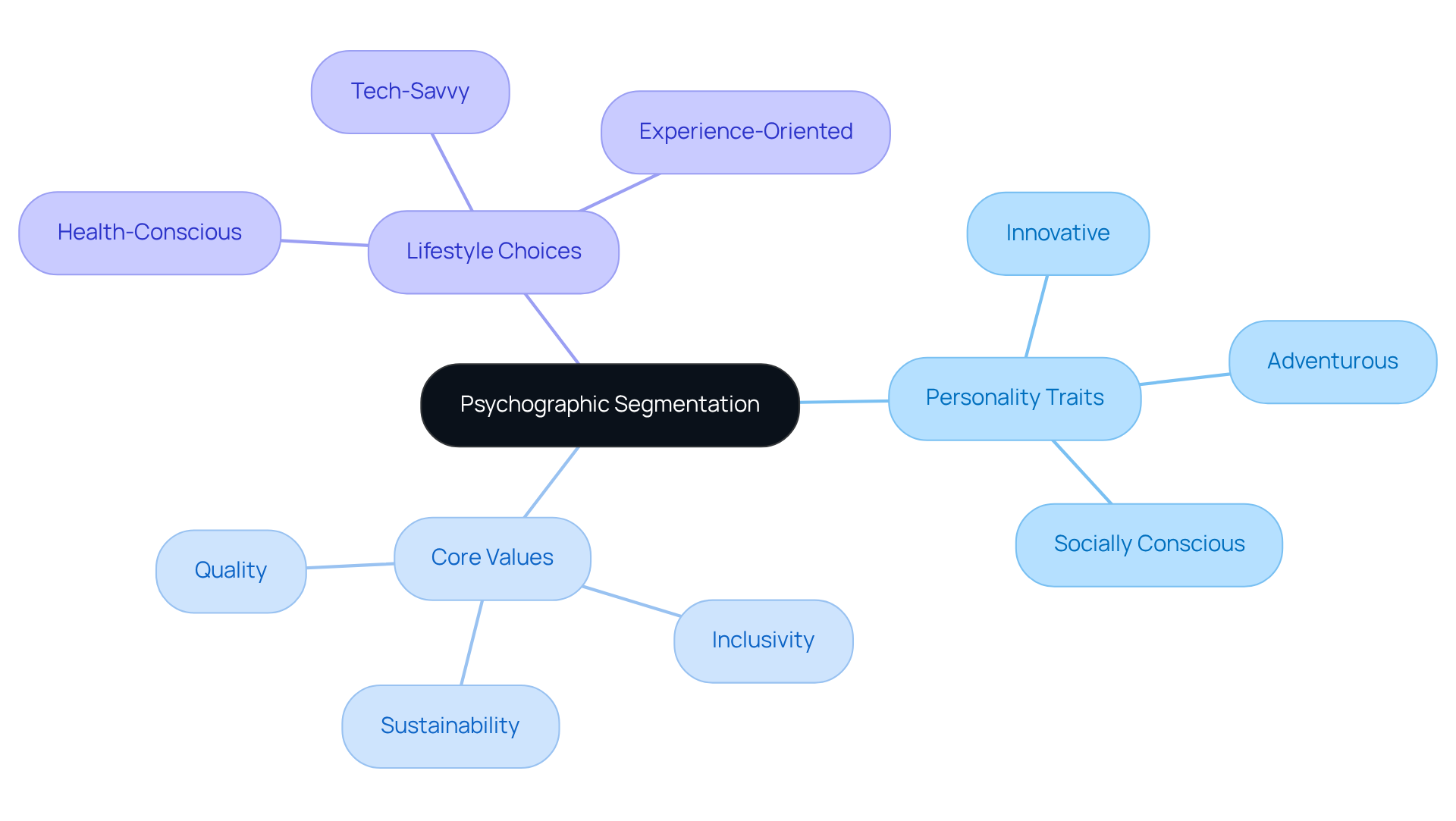
Psychographic vs. Behavioral Segmentation: Key Differences and Applications
The psychographic segmentation definition delves into the psychological dimensions of buyer behavior, focusing on motivations, values, and lifestyle choices. In contrast, behavioral segmentation categorizes individuals based on their actions, such as purchase history and website interactions. For instance, while behavioral insights might reveal that a customer frequently buys fitness products, a lifestyle analysis could uncover that this individual prioritizes health and wellness as part of a broader commitment to their lifestyle. Notably, a recent study found that 40% of participants expressed a keen interest in extreme sports, illustrating how behavioral insights can inform targeting strategies for niche consumer interests.
By integrating these two approaches, companies gain a comprehensive understanding of their audience. Merging psychological insights with behavioral data allows businesses to craft nuanced marketing strategies that resonate on a deeper level. For example, a fitness company could leverage behavioral data to identify regular purchasers and then apply insights into their motivations to tailor messaging that aligns with their customers' wellness aspirations. This dual strategy not only boosts targeting effectiveness but also cultivates stronger emotional connections with consumers. Most companies find that the psychographic segmentation definition suggests 3 to 5 psychographic segments are optimal for precise targeting, providing a practical guideline for direct-to-consumer (DTC) brands.
Experts emphasize that employing both segmentation strategies is vital for success in today's market. As one expert succinctly stated, "Demographics tell you who your customer is. Psychographics tell you why they buy." This integration empowers companies to create personalized experiences that reflect customer values, ultimately enhancing engagement and loyalty. Furthermore, as buyer expectations evolve, brands must strive to truly understand their customers rather than merely sell to them, underscoring the significance of lifestyle-based segmentation in the current marketing landscape.
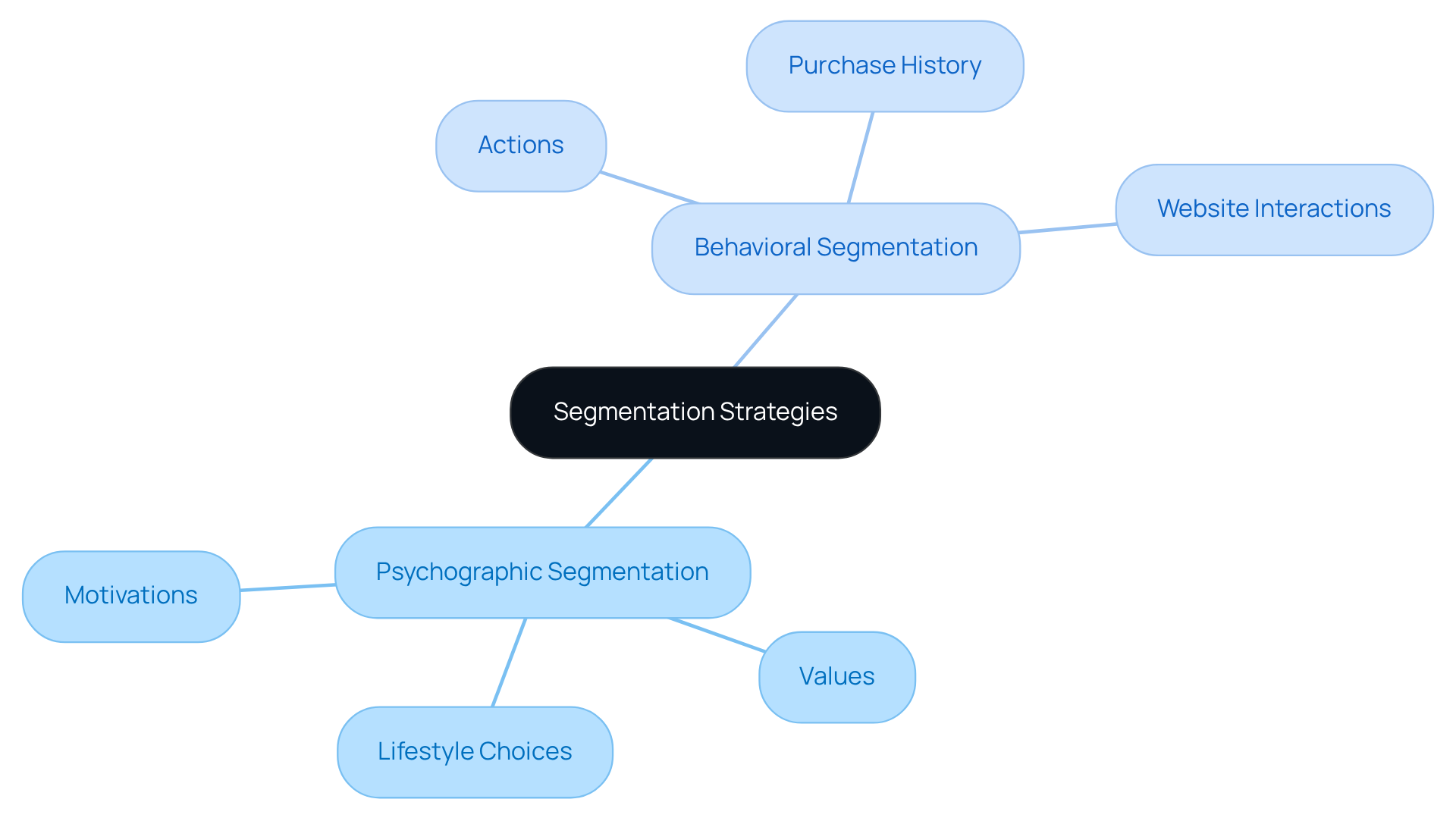
Challenges of Psychographic Segmentation: Navigating Limitations and Misconceptions
The psychographic segmentation definition provides critical insights into buyer behavior, yet it presents notable challenges. One major obstacle is the complexity of data collection, which often necessitates extensive surveys, interviews, and behavioral analysis. This process can be both time-consuming and costly, potentially leading to gaps in understanding the true psychographic profiles of target audiences. Furthermore, biases in interpretation can skew outcomes, as marketers may inadvertently rely on stereotypes or simplistic assumptions about buyer motivations.
For instance, companies like Glossier have adeptly navigated these challenges by engaging directly with their community. They utilize social listening to gather detailed insights that inform product development. This strategy not only enhances accuracy but also cultivates a deeper connection with consumers. However, many brands continue to grapple with the reliability of self-reported data, which can result in discrepancies between stated values and actual purchasing behavior.
Data scientists stress the necessity of a critical mindset when interpreting psychographic data. They advocate for a multi-faceted approach that integrates psychographics with demographic and behavioral data, creating a more comprehensive view of consumers. This hybrid strategy can mitigate biases and enhance the effectiveness of promotional campaigns.
Despite these hurdles, the psychographic segmentation definition highlights its potential to drive engagement and loyalty substantially. Businesses that invest in understanding the psychological factors influencing their clients can develop more impactful promotional messages, ultimately leading to improved conversion rates and customer satisfaction. For example, Parah Group's collaboration with a $30M clothing label involved tailored strategies that addressed buyer motivations and behaviors, resulting in a remarkable 35% increase in conversion rates and a 10% rise in revenue per visitor. As the landscape of buyer behavior continues to evolve, reassessing and refining psychological profiles will be essential for maintaining relevance and effectiveness in promotional strategies.
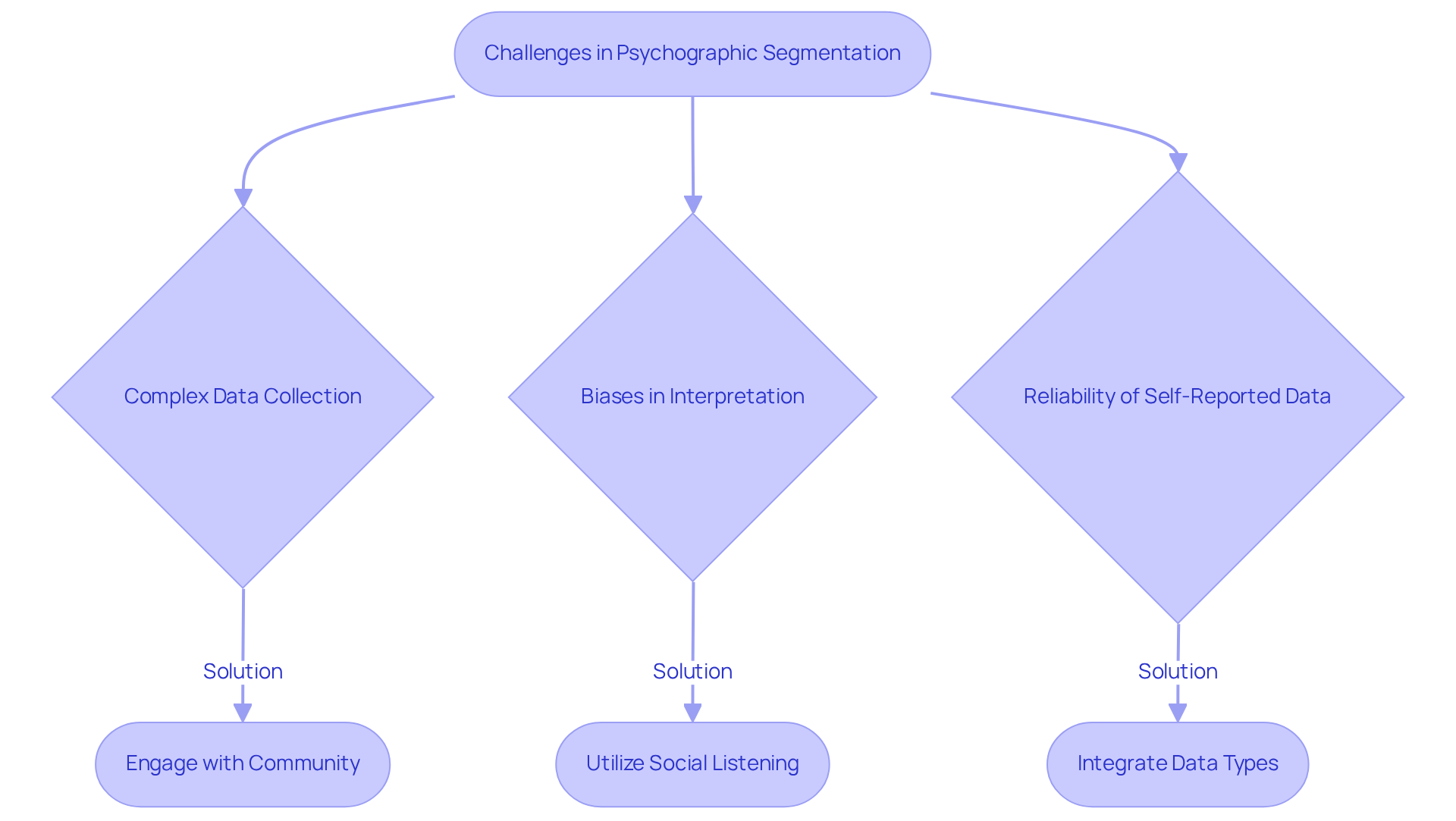
Key Takeaways on Psychographic Segmentation: Implementing Insights for Success
To effectively implement the psychographic segmentation definition, companies must prioritize the collection and analysis of relevant data that uncovers consumer motivations, allowing for tailored strategies. Understanding consumer values is crucial; brands that align their messaging with these values can significantly boost engagement and loyalty. For instance, personalized messaging has been shown to achieve transaction rates six times higher than generic approaches, underscoring the power of targeted communication in direct-to-consumer (DTC) marketing.
Moreover, integrating behavioral insights with other segmentation methods leads to a more comprehensive understanding of the customer base. Brands that embrace these strategies not only improve their promotional effectiveness but also drive sustainable growth. This is evidenced by companies that have realized a staggering 760% increase in revenue through segmented campaigns. Additionally, organizations that implement psychographic segmentation are 60% more likely to grasp their customers' challenges and concerns, further highlighting the advantages of this approach.
Looking ahead to 2025, focusing on customer values in promotional strategies will be vital. Companies that resonate with their audience's beliefs and aspirations are poised to excel in a competitive landscape. Parah Group exemplifies this approach with its expert conversion rate optimization (CRO) strategies, which aim to maximize profitability by aligning paid advertisements and landing pages with consumer insights.
Furthermore, brands leveraging Customer Data Platforms (CDPs) experience campaign activation three times faster and achieve a 30% higher return on investment (ROI). This emphasizes the significance of data-driven strategies in enhancing marketing effectiveness.

Conclusion
Psychographic segmentation is a crucial framework for direct-to-consumer (DTC) brands looking to elevate their marketing effectiveness and forge deeper connections with customers. By honing in on the psychological traits, values, and lifestyles of consumers, brands can craft targeted strategies that resonate personally, ultimately driving engagement and loyalty.
Key insights throughout this article illustrate how psychographic segmentation empowers brands to sharpen their marketing efforts. Companies like Parah Group, Nike, and Airbnb serve as prime examples, showcasing the tangible benefits of grasping consumer motivations. This understanding leads to significant boosts in conversion rates and customer satisfaction. Moreover, integrating psychographic data with behavioral insights enriches marketing strategies, enabling nuanced targeting that adapts to evolving consumer needs.
As consumer behavior continues to evolve, embracing psychographic segmentation becomes essential for brands striving to stay relevant. Companies should invest in data collection and analysis techniques that reveal valuable insights into their audiences. By aligning marketing messages with consumer values and aspirations, brands can cultivate enduring relationships, ensuring long-term success in an increasingly competitive landscape.
Frequently Asked Questions
What is psychographic segmentation?
Psychographic segmentation is a marketing tool that classifies individuals based on their psychological characteristics, including personality traits, values, interests, and lifestyles, allowing companies to understand deeper motivations and preferences that drive consumer behavior.
How does Parah Group utilize psychographic segmentation?
Parah Group leverages psychographic segmentation to refine its Conversion Rate Optimization strategies by understanding the motivations, interests, and values of target consumers, enabling the creation of personalized marketing messages and user experiences that resonate with potential customers.
What are some results achieved by companies using Parah Group's strategies?
A direct-to-consumer clothing company saw a 35% increase in conversion rates and a 10% boost in revenue per visitor after optimizing their homepage and product pricing. Similarly, Grab Green experienced an 80% increase in average order value through strategic pricing tests and bundling options.
Why is first-party data collection important for DTC companies?
First-party data collection is crucial for DTC companies as it allows them to develop detailed client profiles, enabling more customized promotional efforts and enhancing customer loyalty and marketing efficiency.
What are the benefits of psychographic segmentation?
The benefits of psychographic segmentation include improved targeting, heightened customer engagement, and strengthened loyalty. This approach allows companies to craft relevant and compelling messages, significantly boosting conversion rates and fostering enduring customer relationships.
Can you provide examples of companies successfully using psychographic segmentation?
Patagonia connects with eco-conscious shoppers by emphasizing sustainability in its communications, enhancing customer loyalty. Spotify uses psychological data to curate personalized playlists, resulting in increased user engagement and satisfaction.
What impact does audience targeting have on customer engagement?
Targeted campaigns can lead to a staggering 760% increase in revenue, with 74% of marketers believing targeted personalization significantly enhances overall customer engagement, solidifying customer loyalty and encouraging repeat business.
FAQs











